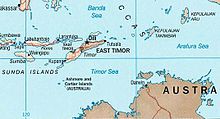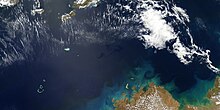Timor Sea
The Sunda Trench marks the deepest point of the Timor Sea with a depth of more than 3300 metres, separating the continents of Oceania in the southeast and Asia to the northwest and north.
The counterpart of that body of water, the 'Ombai-Wetar Strait', which has smaller waves, is less turbid, and washes most of Timor island's northern shores, is commonly referred to in Tetum as tasi feto (lit. transl.
Its deepest point is the Timor Trough (which some geologists consider is the south-eastern extension of the Java Trench, but others view as a foreland trough to the Timor Island "mountain range"), located in the northern part of the sea, which reaches a depth of 3,300 m (10,800 ft).
In May 2010, it was announced that a crater about 50 km (31 mi) wide has been discovered on the seabed of the Timor Sea.
[6] The International Hydrographic Organization (IHO) defines the Timor Sea as being one of the waters of the East Indian Archipelago.
The Western [limit] of the Arafura Sea [A line from Cape Don to Tanjong Aro Oesoe, the Southern point of Selaroe (Tanimbar Islands)].
On the 19 February 1942 the Japanese aircraft carrier Kaga with other vessels, launched air strikes against Darwin, Australia, sinking nine ships, including the USS Peary.
1 well in June 1974 on the Troubadour Shoals about 200 kilometres (120 mi) southeast of Timor, and intersected 83 metres (272 ft) of hydrocarbons.
A gas pipeline crosses the Timor Sea from the Joint Petroleum Development Area to Wickham Point near Darwin.
[1] In response to the disaster, Indonesian seaweed farmers engaged in a class action lawsuit to claim for damages.
At around the same time, construction commenced on a 500 km (310 mi) subsea natural gas pipeline connecting the Bayu-Undan processing facility to a liquefied natural gas plant situated at Wickham Point in Darwin harbour.
The Greater Sunrise gas field, discovered in 1974, is one of the largest in the area and is expected to earn East Timor several billion dollars in royalty revenues.
[18] These disagreements initially involved Australia and Indonesia, although a resolution was eventually reached in the form of the Timor Gap Treaty.
From 1965 to 2018, Australia's territorial claim extended to the bathymetric axis (the line of greatest sea-bed depth) at the Timor Trough.
This organisation is responsible for the administration of all petroleum-related activities in a part of the Timor Sea known as the Joint Petroleum Development Area (JPDA).
[18] Under the terms of the treaty, royalties on petroleum production in the JPDA are split in a 90:10 ratio between East Timor and Australia.





